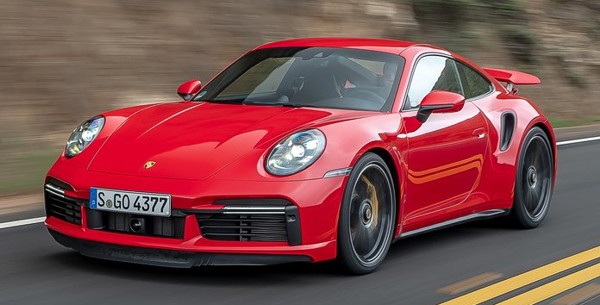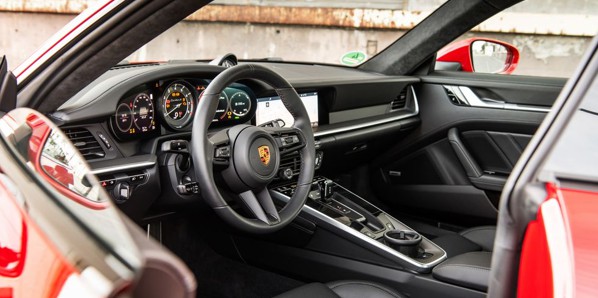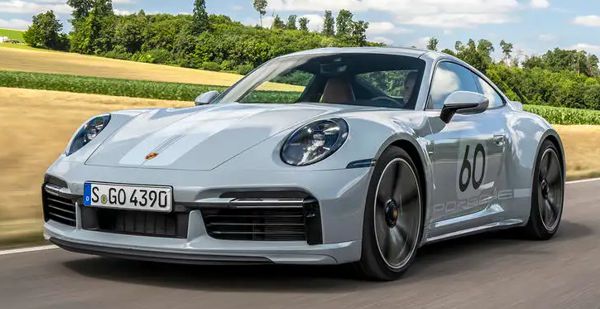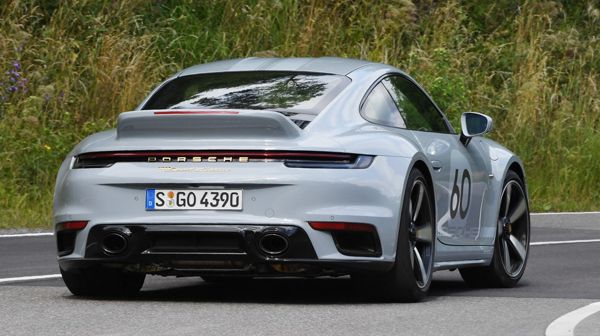Published
on 17
Apr 2020
|
All rights reserved.
|
|
|

|
|
The
widest, heaviest, most powerful and faster ever 911 Turbo. Is it too
much to enjoy on the road?
|
|
Traditionally, 911 Turbo
targets at those wanting supercar performance without sacrificing day
to day usability. On the one hand, it provides big power, thick torque
and 4-wheel traction for astonishing pace and all-weather
handling. On the other hand, it offers all the space, creature comfort
and ease of use more akin to a GT. Bridging the gap between
high-performance sports cars and grand tourers, it finds a unique
living space.
The latest 911 Turbo is built on the 992 platform. Like the lesser
Carrera models, its biggest change is a wider body. Its front track is
widened by a considerable 42mm, allowing the nose to grip harder and
resist understeer stronger. Meanwhile, the rear track is widened by
10mm and, in addition to wider tires, the body
width is extended by 20mm to as much as 1900mm. In fact, almost each
generation of 911 Turbo grew wider. Remember the original 930 and 964
Turbo measured only 1775 mm across shoulders? It grew to 1795 mm in 993
Turbo, 1830 mm in 996 Turbo, 1852 mm in 997 Turbo and 1880 mm in 991
Turbo. The latest 911 Turbo is no longer compact enough to thread
through narrow country roads without concerning the cars in opposite
lane. However, on open roads or tracks, you should appreciate the extra
grip and
traction generated by its massive, 315/30ZR21 rear tires (as well as
the 255/35ZR20 front), wrapped around the largest ever, 21-inch alloy
wheels. This calls for a more pronounced rear fenders which are easy to
spot. If that’s not enough, you can always distinguish the Turbo from
lesser Carreras by the intakes on rear fenders.

|
|
Now
1900mm wide, it is no longer compact enough to thread through narrow
roads without concerning cars in opposite lane...
|
|
Another feature of the Turbo is a rear spoiler that always sit atop the
engine lid, unlike the one on Carrera that normally rests flush with
the
tail. Its upper foil can be raised at speed or at your request to
generate more downforce, which amounts to 170 kg at 160 mph. When
lowered, drag
coefficient drops from 0.38 to 0.33, by then you can test its
205 mph potential. Like its predecessor, inside the front overhang
there
are movable flaps to vary drag and downforce according to needs. That
said, the aerodynamics of 911 Turbo is not particularly advanced, as it
has no room for diffusers.
Like other 992 models, its monocoque chassis is now made of more
aluminum than steel, while the entire body is aluminum. That said, with
heavier duty engine, transmission, brakes and everything, the 992 Turbo
cannot escape from the fate of increasing weight. Kerb weight is up by
40 kg to 1640 kg for the Turbo S model discussed there. Speaking of
models, strangely, this time Porsche decided to launch the Turbo S
first while keeping the cheaper Turbo in secret. However, conventional
wisdoms tell us the Turbo will offer a few dozen less horsepower
(probably more than the 40hp deficit last time) and steel instead of
ceramic brakes. The ceramic brakes of Turbo S is really astonishing –
420mm and 10-piston calipers up front; 390mm and 4-piston at the rear.
They are more powerful than ever.
The rest of the chassis are mostly carried over from the 991:
adaptive dampers, active anti-roll bars, adaptive engine mounts and
active rear-wheel steering. The suspension layout is the same, although
the wider track necessitates different geometry and tuning, and it
adopts helper springs like the GT2 RS. As adaptive
dampers become standard, the PASM name is now associated with the word
“sport suspension” to denote the option of 10mm lower and stiffer
suspension setup.

|
|
0-60
mph takes merely 2.6 seconds. Only a handful of supercars could be
quicker, regardless of price.
|
|
However, the highlight of 911 Turbo remains to be its engine. While the
engine cover is
marked “3.8 turbo”, more precisely speaking it is a 3.75-liter unit,
because its capacity is reduced slightly from 3800 to 3746 c.c. by
shortening stroke from 77.5 to 76.4 mm. In fact, this engine is not
developed
from the old car's but the 3.0-liter
unit of Carrera with codename 9A2 Evo. Its short stroke is shared with
the latter, while bore is
enlarged to 102 mm. Further changes include the use of piezo injectors,
larger intake system and gasoline particulate filters to clean up
emission. The
tuning philosophy is closer to the GT2 RS, which uses higher boost
pressure and lower compression. The larger VTG turbos generate as high
as 1.55 bar, the same as GT2 RS or 0.2 bar more than the old Turbo S.
Compression ratio is reduced from 9.8:1 to 8.7:1. The
cooling system is also overhauled. The intercooler is not only larger
but also moved to the top of the engine to take advantage of cooling
air flow. The charge-air coolers are moved to the back of the engine,
while air filters are relocated to the sides. Consequently, the new
motor produces 650 horsepower at 6750 rpm, 70 ponies more than its
predecessor. Peak torque is improved from 516 lbft (or 553 lbft on
overboost) to a consistent 590 lbft, now released at 2500-4000 rpm. It
gets
remarkably close to the territory of GT2 RS.
The stronger torque means it needs a redesigned gearbox and all-wheel
drive system to handle. The new 8-speed PDK has bigger clutches to do
the job, and 2 over-drive ratios to improve fuel economy. The reworked
Haldex multi-plate clutch can transfer more, up to 369 lbft of torque
to the front axle.
The Turbo S now takes merely 2.6 seconds to sprint from rest to 60 mph,
2/10ths quicker than before. 0-124mph takes 8.9 seconds, or 0.4s
shorter.
Although it is not quite as fast as the GT2 RS or junior supercars like
Ferrari F8 or McLaren 720S (both take only 7.8 seconds), for a car that
works as your daily transport, that is safe to drive in all weather and
seasons, it is about as fast as you can get. An everyday supercar, you
may say.
 |
|
A
nice place to spend you time.
|
|
With the new interior, it is easier than ever to live with. Build
quality is superb. Infotainment system is advanced and well designed.
Touchscreen and instrument display are both large and show crisped
graphics. It looks sophisticated, yet the dashboard design takes a
retro theme inspired by the classic 911, including the 5-gauge
instrument – although only the center tachnometer is real. Traditional
merits of the 911 remain: great visibility, roomy cabin, superb seats
and driving position, and the rear seats are useful to place extra
luggage that the smallish front boot cannot.
Drive in Comfort mode leisurely, the Turbo S is also a rather
comfortable car to get along. Its engine is relatively calm around
town. While the suspension is not exactly supple, like all 911s, it is
smooth enough to take you everywhere as long as you leave it in Comfort
mode. Moreover, there are all sorts of safety and driving assistance
systems that normally ignored by low-volume exotic cars, such as
collision avoidance system, adaptive cruise control, 360-degree parking
camera and a Wet mode. The only complaint here is the intrusive road
noise generated by those beefy rubbers. Otherwise, the 911 Turbo could
be a decent alternative to conventional grand tourers like Aston Martin
DB11.
But once you turn the mode selector to Sport or Sport+, plant you foot
on throttle and the car becomes a beast. With traction superior to any
front or mid-engined cars, the 911 Turbo launches like a rocket while
producing a deep, purposeful howl. There is no much turbo lag, just a
relentless stream of power from a little more than 1000 rpm and it
keeps revving until the 7200 rpm cutout with no signs of fatigue. The
power delivery is smooth, the PDK gearshift is seamless, supercar
performance could not have been easier.
 |
|
The
only problem is, when the performance envelop is pushed so far beyond
your reach, it feels too good to exploit on roads.
|
|
On narrower mountain roads, you do aware the extra width which makes
the new Turbo less exploitable. But once you find an empty road, its
cornering limit is astonishing. The nose sticks to the intended path
better than any 911 Turbos before and the rear-wheel steering sharpens
the turn-in, keeps understeer at bay. The quick steering feels sharp
while its weighting and linear response are exactly what you expect
from Porsche. The roadholding and poise are exceptional. On Sport or
Sport+ mode the suspension is pretty firm, but the damping is good,
keeping the car composed over bumps or undulations. There is less pitch
as well under braking or coming over bumps. The car understeers a bit
when approaching corner, but that is necessary to keep its tail-heavy
balance in check. You can still provoke it into oversteer at your
desire.
The only problem is, when the performance envelop is pushed so far
beyond your reach, the 911 Turbo feels too good to exploit on roads.
You need a track to get close to its limit and play with its adjustable
balance. A Ferrari F8 or 488 Pista feels more alive on a mountain road,
allowing you to oversteer on every hairpin. The 4-wheel-drive Porsche
is calmer and less emotional, or in other words, more Germanic. You
can’t help feeling it is now too fast for the road. The GT3 and GT3 RS
are more playful and more engaging, while the Carrera S is just as
quick on normal roads. Moreover, as the latter is now also turbocharged
and
very quick indeed (0-60 takes 3.4 seconds), its driving experience
feels remarkably close to the flagship Turbo S, at least until you take
the car to a track. What leaves the drivers of 911 Turbo is merely a
psychological advantage, knowing they own the fastest and the most
expensive (£156,000) road-going production Porsche, but not
necessarily feel that often. That is the real problem of the 992 Turbo.
|
Verdict:     |
Published
on 26
Oct 2022
|
All rights reserved.
|
|
911 Sport Classic
|
|

|
|
Sport
Classic is retro take on classic 911 Turbo, with rear-drive and manual
gearbox to delight purists.
|
|
Surfing through Porsche’s
website, you will find as many as 13 models in the 911 range, and
that’s before considering different roofs. Surprisingly, sitting atop
at
the price chart is this 911 Sport Classic. It is neither the fastest
nor the most exotic 911 available, but a retro edition built by the
company’s “Exclusive Manufaktur” department as the Heritage
series. Porsche did that before with the first 911 Sport Classic in
2009, but that car was limited to only 250 units, while this batch will
increase to 1250 cars, which makes its £214,200 price tag sounds
irrational.
Well, luxury cars are always irrational. If you care about money, you
are unlikely the kind of customers Exclusive Manufaktur targets at.
These days many rich people are willing to pay a million dollars to
secure a retro Singer 911 or just about any restomods or reimagined
classics. As the
automotive world is getting closer and closer to the deadline of
selling combustion cars, demand for such "modern classics" will only
grow in the foreseeable future. The
Heritage
line is created to capitalize the thick profit margin enabled by such
creations.

|
|
Exterior
takes inspiration from the classic 2.7 RS.
|
|
So what is the Sport Classic? In short, it is a retro interpretation of
911 Turbo. Based on the wide body of Turbo, it uses the Turbo’s
3.8-liter motor instead of the Carrera’s 3.0-liter unit, but detuned to
550 horsepower and 442 pound-foot of torque so that it can adopt the
7-speed manual gearbox of the Carrera models. Also gone together with
the PDK transmission is the 4-wheel drive system which has been made
standard on any
Turbo models since 993 (that’s 28 years ago). This sounds more pleasing
to
purists yet saves 70 kg. Cosmetically, the Sport Classic takes
inspiration from the classic Carrera 2.7 RS instead, using a “ducktail”
rear
spoiler to produce 50 kg downforce while taking the sole responsibility
of feeding and cooling the flat-six engine, because it ditches the
Turbo’s side intakes for purer looking rear fenders. It also has
stripes paint jobs and "Porsche" wording decals that mirror the classic
Carreras.
While £214,200 sounds absurd for a detuned 911 Turbo, at least it
is equipped with
many standard features, such as PCCB ceramic brakes, 4-wheel steering,
active anti-roll bars and active differential. Moreover, its bonnet and
double-bubble roof are made of carbon-fiber like the outgoing GT2 RS.
Inside, the retro theme is obvious with the houndstooth cloth seats
and door trims, which is quite tasteful. It is no more luxurious than
the regular Turbo, but you pay for exclusivity.

|
|
In
spite of unique trims, the performance and driver engagement fails to
live up to its price tag.
|
|
On the road, the Sport Classic is much slower than the Turbo S, of
course. Having lost 4-wheel drive and quick-shifting dual-clutch
gearbox, not to
mention 100 horsepower and 150 lbft of torque, it takes 4 seconds to go
from rest to 60 mph, a massive 1.4 second slower than its cheaper
sibling. By the time it reaches 124 mph, it is already more than 3
seconds behind. Judging from performance alone, there is really no
reason to buy it. In fact, a Carrera S PDK that costs half the
money is just as quick as the Sport Classic.
However, just as I mentioned in the last review, the Turbo S is way too
quick for road driving. Its performance is so high that almost
impossible to exploit its deep reserves on public roads. This means,
the Sport Classic rarely feels slower in the real world. You can use
more of its performance. It might have lost 4-wheel traction, but on
dry surfaces at least its 315/30ZR21 P-Zero rubbers still generate
plenty of traction. Its front rubbers still grip hard and refuse to
understeer. It still takes some serious provocation to unstick its rear
axle, only then you will find it a little more mobile and engaging to
drive than the Turbo.
The lack of drive to the front wheels does not transform its steering
feel, but less weight at the nose does sharpen its turn-in a little.
That said, it should have been more engaging still. Unlike the smaller
Carrera engine, the 3.8 unit has
its torque curve reaching a plateau from 2000 rpm all the way to 6000
rpm, offering no rewards to work harder. The 7-speed manual gearbox is
no match for the 6-speeder on GT3, not only the gearshift less precise,
but the strange gate pattern is unintuitive, easy to slot into the
wrong gear. If you don’t look for exclusivity, a Carrera GTS will be
just as fun and save you £100,000. Or even better, why not buy
both Carrera S and Cayman GT4 RS for the same money?
|
Verdict:    |
|